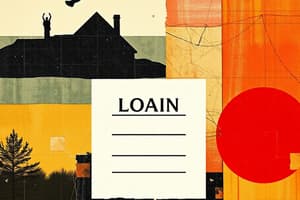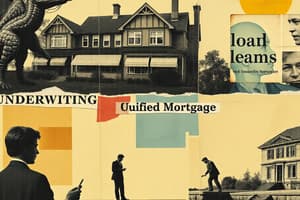Podcast
Questions and Answers
What does the loan underwriter primarily analyze to determine loan eligibility?
What does the loan underwriter primarily analyze to determine loan eligibility?
- Assets, income, debt, credit history, and property (correct)
- Assets, income, and insurance coverage
- Credit score, collateral, and job stability
- Income, credit history, and previous loan performance
What is the correct calculation for a 5% down payment on a home valued at $200,000?
What is the correct calculation for a 5% down payment on a home valued at $200,000?
- $7,500
- $10,000
- $5,000
- $8,000 (correct)
How is the Maximum Loan-To-Value (LTV) Ratio calculated?
How is the Maximum Loan-To-Value (LTV) Ratio calculated?
- Multiply the sales price by the minimum required down payment percentage
- Divide the loan amount by the appraised value
- Multiply the lower of sales price or appraised value by the LTV ratio expressed in decimals (correct)
- Add the down payment and sales price, then divide by appraised value
What does the Combined Loan-To-Value (CLTV) Ratio include in its calculation?
What does the Combined Loan-To-Value (CLTV) Ratio include in its calculation?
What does the term 'assets' refer to in the context of borrower qualifications?
What does the term 'assets' refer to in the context of borrower qualifications?
Which element is NOT part of the borrower's qualification analysis?
Which element is NOT part of the borrower's qualification analysis?
To calculate the LTV based on a down payment, what is the first step?
To calculate the LTV based on a down payment, what is the first step?
What aspect of loan processing is ongoing even before an application takes place?
What aspect of loan processing is ongoing even before an application takes place?
How should a borrower's monthly income be calculated if they receive payment bi-weekly?
How should a borrower's monthly income be calculated if they receive payment bi-weekly?
When assessing a self-employed borrower's income, what method is typically used?
When assessing a self-employed borrower's income, what method is typically used?
What is needed to qualify cash income reported on an application for a mortgage?
What is needed to qualify cash income reported on an application for a mortgage?
How is non-taxable income adjusted for mortgage qualification purposes?
How is non-taxable income adjusted for mortgage qualification purposes?
What must be done if a borrower reports gaps in employment when qualifying for a mortgage?
What must be done if a borrower reports gaps in employment when qualifying for a mortgage?
What qualifies as acceptable income for mortgage qualification from asset income?
What qualifies as acceptable income for mortgage qualification from asset income?
Which of the following income types is typically not used for mortgage qualification?
Which of the following income types is typically not used for mortgage qualification?
If a borrower owns 25% or more of a business that employs them, how is their income categorized?
If a borrower owns 25% or more of a business that employs them, how is their income categorized?
What may be added back to a self-employed borrower's income when calculating for mortgage qualification?
What may be added back to a self-employed borrower's income when calculating for mortgage qualification?
How should seasonal work income be calculated for mortgage qualification?
How should seasonal work income be calculated for mortgage qualification?
What is the purpose of asset verification in a mortgage transaction?
What is the purpose of asset verification in a mortgage transaction?
Which type of assets are typically verified by a Verification of Deposit form?
Which type of assets are typically verified by a Verification of Deposit form?
Why is physical cash on hand not considered for mortgage qualification?
Why is physical cash on hand not considered for mortgage qualification?
Which statement about nonphysical assets is true?
Which statement about nonphysical assets is true?
What must be verified for equity assets to be acceptable as cash to close?
What must be verified for equity assets to be acceptable as cash to close?
Under which condition can overtime income be considered for loan qualification?
Under which condition can overtime income be considered for loan qualification?
What is a critical consideration when documenting recent increases in average balances of assets?
What is a critical consideration when documenting recent increases in average balances of assets?
Which of the following assets typically requires appraisal verification if sold to meet cash requirements?
Which of the following assets typically requires appraisal verification if sold to meet cash requirements?
What is an example of a fixed-income asset?
What is an example of a fixed-income asset?
Which of the following statements is true regarding fixed assets and their verification?
Which of the following statements is true regarding fixed assets and their verification?
What is the main reason for verifying liquid assets?
What is the main reason for verifying liquid assets?
If a borrower provides a bi-weekly salary, how is annual income calculated?
If a borrower provides a bi-weekly salary, how is annual income calculated?
What is a common requirement when using a loan secured by an asset for qualification?
What is a common requirement when using a loan secured by an asset for qualification?
Flashcards
Borrower Qualification Analysis
Borrower Qualification Analysis
The process of evaluating a borrower's financial situation to determine their ability to repay a loan.
Down Payment Requirement
Down Payment Requirement
The percentage of the property's value that a borrower needs to pay upfront, typically expressed as a decimal.
Loan-To-Value (LTV) Ratio
Loan-To-Value (LTV) Ratio
The maximum amount of loan a borrower can take out, calculated as a percentage of the property's value, often expressed as a decimal and is the inverse of the down payment requirement.
Combined Loan-To-Value (CLTV) Ratio
Combined Loan-To-Value (CLTV) Ratio
Signup and view all the flashcards
Assets
Assets
Signup and view all the flashcards
Verification Process
Verification Process
Signup and view all the flashcards
Automated Underwriting System
Automated Underwriting System
Signup and view all the flashcards
ATR/QM Rule (Ability to Repay/Qualified Mortgage Rule)
ATR/QM Rule (Ability to Repay/Qualified Mortgage Rule)
Signup and view all the flashcards
Cash and Cash Equivalents
Cash and Cash Equivalents
Signup and view all the flashcards
Physical Assets
Physical Assets
Signup and view all the flashcards
Nonphysical Assets
Nonphysical Assets
Signup and view all the flashcards
Liquid Assets
Liquid Assets
Signup and view all the flashcards
Fixed Assets
Fixed Assets
Signup and view all the flashcards
Equity Assets
Equity Assets
Signup and view all the flashcards
Fixed-Income Assets
Fixed-Income Assets
Signup and view all the flashcards
Asset Verification
Asset Verification
Signup and view all the flashcards
Verification of Deposit (VOD)
Verification of Deposit (VOD)
Signup and view all the flashcards
Income Verification
Income Verification
Signup and view all the flashcards
Overtime Income
Overtime Income
Signup and view all the flashcards
Bi-weekly Income
Bi-weekly Income
Signup and view all the flashcards
Twice per Month Income
Twice per Month Income
Signup and view all the flashcards
Monthly Income Calculation
Monthly Income Calculation
Signup and view all the flashcards
Source of Funds Verification
Source of Funds Verification
Signup and view all the flashcards
Periodically Paid Income
Periodically Paid Income
Signup and view all the flashcards
Seasonal Work Income
Seasonal Work Income
Signup and view all the flashcards
Gaps in Employment
Gaps in Employment
Signup and view all the flashcards
Self-Employed Income
Self-Employed Income
Signup and view all the flashcards
Ownership Threshold
Ownership Threshold
Signup and view all the flashcards
Cash Income
Cash Income
Signup and view all the flashcards
Grossed-Up Non-Taxable Income
Grossed-Up Non-Taxable Income
Signup and view all the flashcards
Asset Income
Asset Income
Signup and view all the flashcards
Down Payment vs. Income
Down Payment vs. Income
Signup and view all the flashcards
Study Notes
Loan Underwriting Process - Borrower Qualifications
- Loan underwriters assess risk by reviewing borrower's assets, income, debt, credit history, and property.
- Verification process and documents confirm ability to repay according to ATR/QM rules.
- Automated Underwriting System (AUS) findings are reviewed and confirmed.
- Analysis begins before application is taken and continues throughout processing.
- Calculations are part of application process and reconfirmed with verification.
Down Payment and Loan-To-Value (LTV) Ratio
- Loan programs have minimum down payment requirements (some have zero).
- Calculate down payment by multiplying lower of sales price or appraised value by required down payment percentage.
- Example: 5% down payment on $150,000 sale = $7,500.
- Down payment ≠ closing costs; some costs included in loan amount.
- LTV ratio is minimum down payment in reverse.
- Calculate LTV by multiplying lower of sales price/appraised value by LTV ratio percentage.
- Example: 95% LTV on $150,000 sale = $142,500.
- LTV can also be calculated based on anticipated down payment.
- Combined LTV (CLTV) considers all mortgages, including purchase money and existing mortgages.
Asset Verification
- Assets are owned property with monetary value (cash/income).
- Asset verification ensures sufficient funds for down payment and closing costs.
- Fund source verification assures no undisclosed loans used.
- Cash reserves after closing are a risk consideration.
- Types of assets:
- Cash & Cash Equivalents: Checking, savings, money markets, CDs; verified by VOD or statements.
- Physical Assets: Tangible, valuable items; usually not verified unless sold for closing cash.
- Nonphysical/Intangible Assets: Trademarks, patents; generally not used for closing.
- Liquid Assets: Quickly convertible to cash (stocks, bonds); verified by statements.
- Fixed Assets: Furniture, real estate; not usually verified.
- Equity Assets: Ownership interest (businesses, securities, life insurance); can be closing cash if verifiable.
- Fixed-Income Assets: Government bonds, securities, CDs; liquid but may have penalties; acceptable as closing funds.
Income Verification
- Borrowers provide two years of employment and income history.
- Income calculation varies based on payment frequency:
- Hourly: Calculate weekly income (base + overtime), then annual, then monthly.
- Bi-weekly: Multiply bi-weekly salary by 26 and then divide by 12.
- Twice per month: Multiply monthly salary by 24 and then divide by 12.
- Annual: Divide annual income by 12 to get monthly income.
- Overtime is considered if consistent history.
- Vacation time is deducted from income calculation.
- Commissions, bonuses, and seasonal work can be averaged.
- Lower income due to gaps in employment may require adjustments.
- Self-employed income is verified using two years of tax returns, adding back non-cash expenses.
- Cash income must be reported on tax returns to be utilized.
- Non-taxable income may be grossed-up (typically 25%).
- Capital gains are usually not used in income calculations.
Additional Considerations
- Borrowers may need to demonstrate ownership of additional assets for future loan payments.
- Asset income (dividends, interest, retirement funds) is considered income.
- Unemployed borrowers can qualify with investment income.
- Income from retirement accounts should be verifiable for three years.
Studying That Suits You
Use AI to generate personalized quizzes and flashcards to suit your learning preferences.




